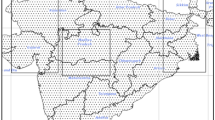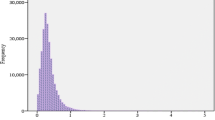Abstract
In the present work, AERONET (AErosol RObotic NETwork) data of 2006–2014 have been used to analyze the variations in aerosol optical depth (AOD) at 500 nm and Angstrom exponent (440/870) (AE). In order to have an in-depth knowledge of aerosol variability, we have analyzed the association of aerosol properties with the meteorological parameters such as temperature, mean sea level pressure, rainfall, dew point, and dust storm frequency. Long-term observations of MODIS-AOD are also validated with AERONET-AOD over Lahore. The peak monthly mean value of AOD is found in July (1.00 ± 0.34) with the corresponding AE value of 0.85 ± 0.29 pointing toward the fact that desert/soil dust aerosols dominated the atmosphere of Lahore. The lowest value of AOD is found in February (0.47 ± 0.26) with the corresponding AE value of 1.22 ± 0.29 representing the presence of urban/industrial aerosols in the atmosphere over Lahore. The monthly mean AE value is found to be maximum in January (1.36 ± 0.15), whereas lowest value of AE is found in June (0.55 ± 0.25). AOD shows positive correlations with temperature, dew point, relative humidity, visibility, rain and dust storm frequency, and negative with mean sea level pressure and wind speed. AE exhibits positive correlations with relative humidity and mean sea level pressure, while with temperature, dew point, visibility, rain and dust storm frequency, it shows negative correlations.





Similar content being viewed by others
References
Cao J (2017) The importance of aerosols in the earth system: science and engineering perspectives. Aerosol Sci Eng 1(1):1–6
Hansen J, Sato M, Ruedy R, Lacis A, Oinas V (2000) Global warming in the twenty-first century: an alternative scenario. Proc Natl Acad Sci 97(18):9875–9880
Liu J, Zheng Y, Li Z, Wu R (2008) Ground-based remote sensing of aerosol optical properties in one city in Northwest China. Atmos Res 89(1):194–205
Liu Z, Liu D, Huang J, Vaughan M, Uno I, Sugimoto N, Kittaka C, Trepte C, Wang Z, Hostetler C (2008) Airborne dust distributions over the Tibetan Plateau and surrounding areas derived from the first year of CALIPSO lidar observations. Atmos Chem Phys 8:5045–5060
Ramachandran S, Kedia S (2013) Aerosol optical properties over South Asia from ground-based observations and remote sensing: a review. Climate 1:84–119
Kaufman YJ, Tanre D, Boucher O (2002) A satellite view of aerosols in the climate system. Nature 419:215–223
Holben BN, Eck TF, Slutsker I, Tanré D, Buis JP, Setzer A, Vermote E, Reagan JA, Kaufman YJ, Nakajima T, Lavenu F, Jankowiak I, Smirnov A (1998) AERONET-A federated instrument network and data archive for aerosol characterization. Remote Sens Environ 66:1–16
Xueliang D, Chune S, Biwen W, Zhenghua C, Suping N, Dongyan H, Hao Z (2012) Analysis of aerosol characteristics and their relationships with meteorological parameters over Anhui province in China. Atmos Res 109–110:52–63
Jintai L, Aaron VD, Jinyuan X, Huizheng C, Yuesi W (2014) Clear-sky aerosol optical depth over East China estimated from visibility measurements and chemical transport modeling. Atmos Environ 95:258–267
Altaratz O, Bar-Or RZ, Wollner U, Koren I (2013) Relative humidity and its effect on aerosol optical depth in the vicinity of convective clouds. Environ Res Lett 8:034025
Mhawish A, Banerjee T, David MB, Amit M, Sachchida NT (2017) Evaluation of MODIS Collection 6 aerosol retrieval algorithms over Indo-Gangetic Plain: implications of aerosols types and mass loading. Remote Sens Environ 201:297–313
David LM, Ravishankara AR, Kodros JK, Venkataraman C, Sadavarte P, Pierce JR, Chaliyakunnel S, Millet DB (2018) Aerosol optical depth over India. J Geophys Res Atmos 123:3688–3703
Tariq S, Ali M (2015) Spatio-temporal distribution of absorbing aerosols over Pakistan retrieved from OMI onboard Aura Satellite. Atmos Pollut Res 6:254–266
ul-Haq Z, Salman T, Ali M, Khalid M, Adila B, Asim DR (2014) A study of tropospheric NO2 variability over Pakistan using OMI data. Atmos Pollut Res 5:709–720
ul-Haq Z, Tariq S, Asim DR, Ali M, Khalid M, Shahid P (2015) Satellite remote sensing of total ozone column (TOC) over Pakistan and neighbouring regions. Int J Remote Sens 36(4):1038–1054
Alam K, Trautmann T, Blaschke T, Hussain M (2012) Aerosol optical and radiative properties during summer and winter seasons over Lahore and Karachi. Atmos Environ 50:234–245
Ali M, Tariq S, Mahmood K, Rana AD, Batool A, Ul-Haq Z (2014) A study of aerosol properties over Lahore (Pakistan) by using AERONET data. Asia-Pac J Atmos Sci 50:153–162
Alam K, Sahar N, Yaseen I (2014) Aerosol characteristics and radiative forcing during pre-monsoon and post-monsoon seasons in an urban environment. Aerosol Air Qual Res 14:99–107
Gupta P, Khan MN, da Silva A, Patadia F (2013) MODIS aerosol optical depth observations over urban areas in Pakistan: quantity and quality of the data for air quality monitoring. Atmos Pollut Res 4:43–52
Hsu NC, Jeong MJ, Bettenhausen C, Sayer AM, Hansell R, Seftor CS, Huang J, Tsay SC (2013) Enhanced deep blue aerosol retrieval algorithm: the second generation. J Geophys Res Atoms 118(16):9296–9315
Holben BN, Tanré D, Smirnov A, Eck TF, Slutsker I, Chatenet B, Lavenue F, Kaufman Y, Castle JV, Setzer A, Markham B, Clark D, Frouin R, Karneli A, O’Neill NT, Pietras C, Pinker R, Voss K, Zibordi G (2001) An emerging ground-based aerosol climatology: aerosol Optical Depth from AERONET. J Geophys Res 106:12067–12097
Kumar M, Parmar KS, Kumar DB, Mhawish A, Broday DM, Mall RK, Banerjee T (2018) Long-term aerosol climatology over Indo-Gangetic Plain: trend, prediction and potential source fields. Atmos Environ 180:37–50
Kaufman YJ, Gitelson A, Karnieli A, Ganor E, Fraser RS, Nakajima T, Matoo S, Holben BN (1994) Size distribution and scattering phase function of aerosol particles retrieved from sky brightness measurements. Geophys Res Lett 99:10341–10356
Kaskaoutis DG, Kambezidis HD (2006) Investigation on the wavelength dependence of the aerosol optical depth in the Athens area. Q J Roy Meteorol Soc 132:2217–2234
Mulcahy JP, O’Dowd CD, Jennings SG, Ceburnis D (2008) Significant enhancement of aerosol optical depth in marine air under high wind conditions. Geophys Res Lett 35:L16810
Guangyu B, Chenbo X, Bangxin W, Wu D, Zhong Z (2015) Case study of the relationship between aerosol angstrom exponent and relative humidity. Chin J Lasers 42(7):0713002
King MD, Kaufman YJ, Menzel WP, Tanre D (1992) Remote-sensing of cloud, aerosol, and water-vapor properties from the moderate resolution imaging spectrometer (MODIS). IEEE Trans Geosci Remote Sens 30:2–27
Petrenko M, Ichoku C, Leptoukh G (2012) Multi-sensor aerosol products sampling system (MAPSS). Atmos Meas Tech 5:913–926
Acknowledgements
We are thankful to NASA, Institute of Space Technology and Pakistan Meteorological Department for providing data.
Author information
Authors and Affiliations
Corresponding author
Rights and permissions
About this article
Cite this article
Tariq, S., ul-Haq, Z. Investigating the Aerosol Optical Depth and Angstrom Exponent and Their Relationships with Meteorological Parameters Over Lahore in Pakistan. Proc. Natl. Acad. Sci., India, Sect. A Phys. Sci. 90, 861–867 (2020). https://doi.org/10.1007/s40010-018-0575-6
Received:
Revised:
Accepted:
Published:
Issue Date:
DOI: https://doi.org/10.1007/s40010-018-0575-6




